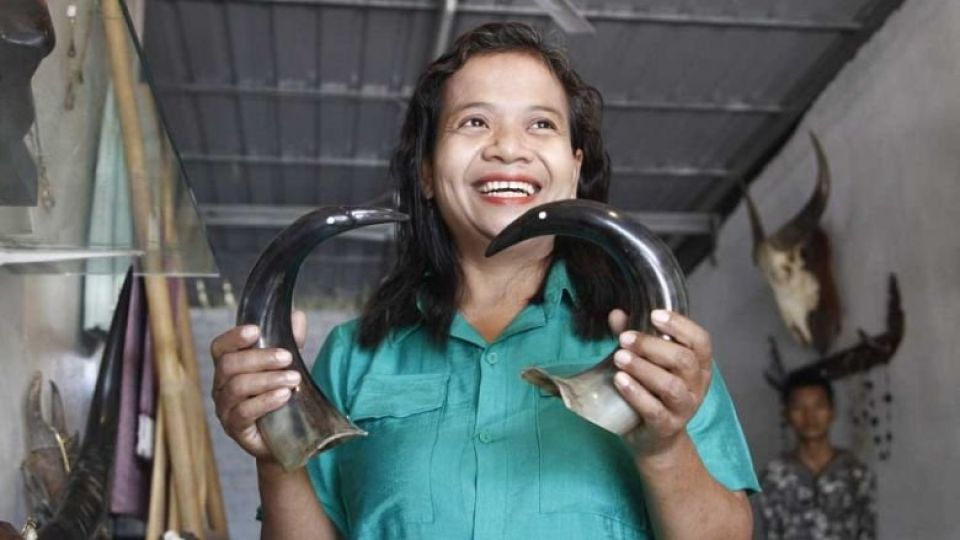January 5, 2023
PHNOM PENH – Cambodian artisans, always on the lookout for ways to repurpose or recycle waste items, have discovered a new resource to make use of here in the Kingdom: Cattle’s horns.
Traditionally, at many slaughterhouses found around the globe, the horns of the cattle being slaughtered are simply tossed away – if they are present on the beast at all by the time it meets its fate, as larger meat processors in many countries will remove the horns long before they are even given much of a chance to grow.
In Cambodia, where cattle are raised in a fashion that is more akin to the methods of old with small herds owned by individual farmers, the horns have mostly been going to waste for years, until now.
Now, local artisans are using those horns as material to make home decor, necklaces, key chains and many other attractive keepsakes.
These natural horn products keep waste out of landfills, which helps the environment, and they have a unique look while being highly durable.
One such artisan is Kuon Chenda, a middle-aged woman who hails from Prey Veng province. Chenda, wearing a light blue dress and always moving about so quickly that it’s like the wind is at her back and pushing her to and fro, makes cattle horns into luxury ornaments, a skill she has long-honed and profited from.
Back in the 1990s, Chenda and her husband left Kampong Leav commune in Prey Veng province to open a small shop located near Choeung Ek Genocidal Centre on the outskirts of the capital because tourism was starting to bring many visitors to that area.
Initially, her husband, also a skilled artisan, was making things to sell in the shop from peacock feathers as well as crab and lobster shell, but no cattle horns back then. However, back then there was a popular soup shop located near her home and shop which would just toss the horns away into a pile where they would rot and cause a terrible smell.
The 41-year-old said that she was annoyed by the stench and she knew the owner of the restaurant wouldn’t do anything to take care of it so she and her husband began to gather the horns, wash them and dry them to store them properly, but back then they hadn’t gotten any ideas yet about what to do them.
Then, later on, with her business failing and money woes mounting, her husband went to a local NGO and learned the skills necessary to make truly valuable and desirable items from the horn.
“Most people spent only three months learning that skill but my husband spent three years learning how to do it. He started out as a student before he became a teacher at that NGO,” she said.

Kuon Chenda talks to a customer at her shop. Heng Chivoan
Eventually, in 2001, Chenda and her husband moved to Phnom Penh and began to sell their handmade horn items to various shops around town who resold them to tourists and other clientele, gradually gaining popularity among both Cambodians and foreigners.
After observing the sustained popularity of cattle horn jewellery items with her foreign clientele she began consistently setting aside horns for that purpose.
“Some horns keep their natural colouring and as the horns grow they will begin to have their own unique colours and shapes. These [horns from older cattle] are often the most beautiful,” she said.
Chenda said that she has noticed over the years that cattle horn products are most popular with foreigners and there isn’t as much support from local people for buying the products despite their having not only been grown and harvested but then handmade in Cambodia.
“Therefore, I am always looking for ways to promote our goods through participation in exhibitions in various places and through the Ministry of Commerce, the Ministry of Tourism or through exhibitions of ‘One Village, One Product’ because we do not have a platform to promote,” she said.
She added that in the past, she used to collect cattle horns herself from the slaughterhouses, but now she has someone who acts as her supplier who delivers them to her place. At the same time, she also buys cattle bones, but only in small amounts because the bones smell worse than the horns because the bone marrow is still inside them.
“In Cambodia, we think there are no investors in really finding ways to make use of mass production of goods with cattle horns yet. In fact, many of the most rotten organic things that are wasted can also be made into natural fertilizers but instead every day we import a lot of chemical fertilizers.
“We all love the beef we eat, but what will we do with the remains of a cow or buffalo? Most of it just rots in the ground or is burned, but it could be used. Overall, a lot of the waste we throw away can be recycled to make money,” she said.
Chenda said she will pass her skills and her commitment to sustainability to future generations because these skills have allowed her and her husband to make enough money to support their family. The best ornaments made from cattle horns can sell for up to $500.
Chenda also requested that Cambodian people support local products, whether it is her handicrafts or someone else’s – whenever anyone can and whatever they can buy Cambodian should be purchased that way.


